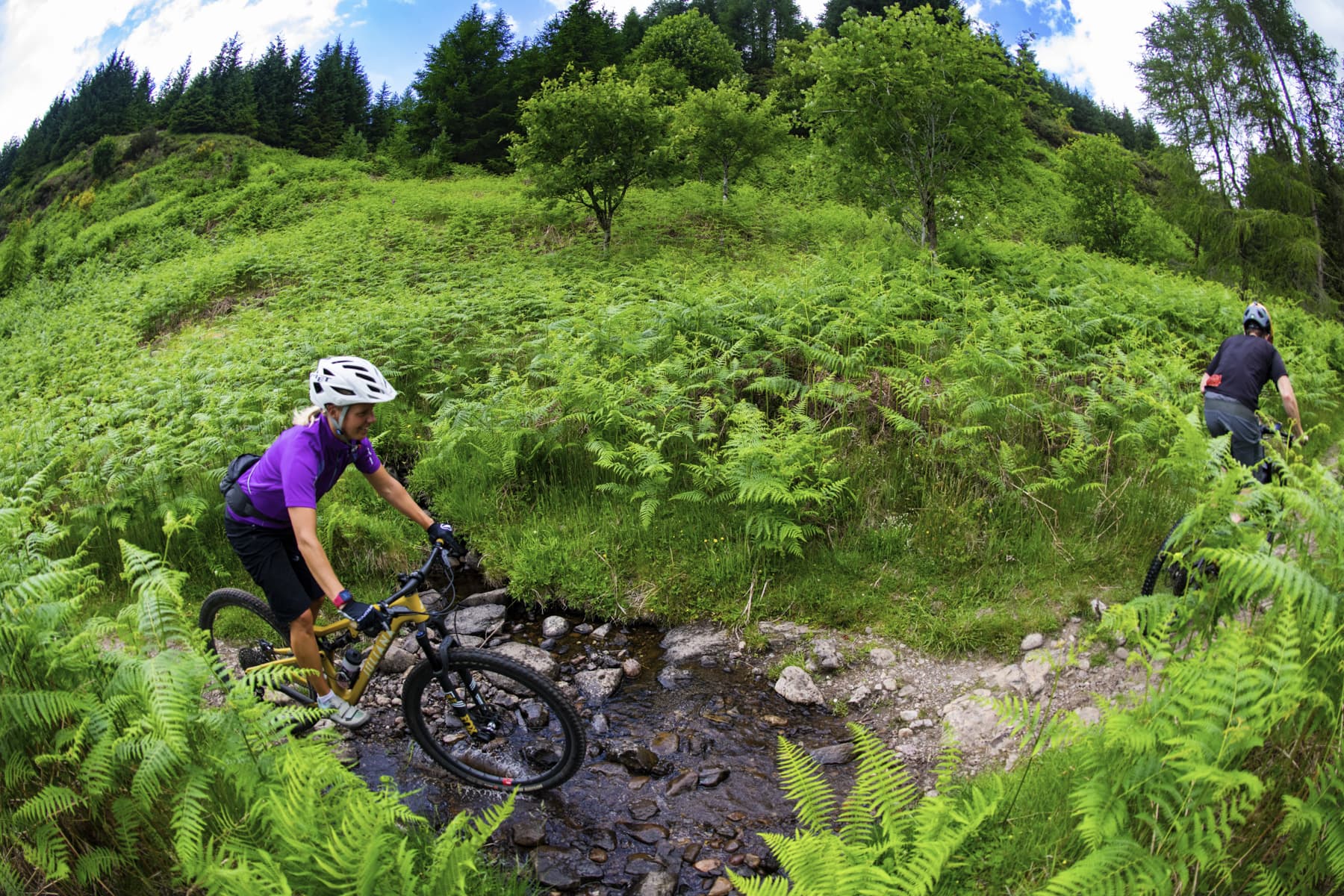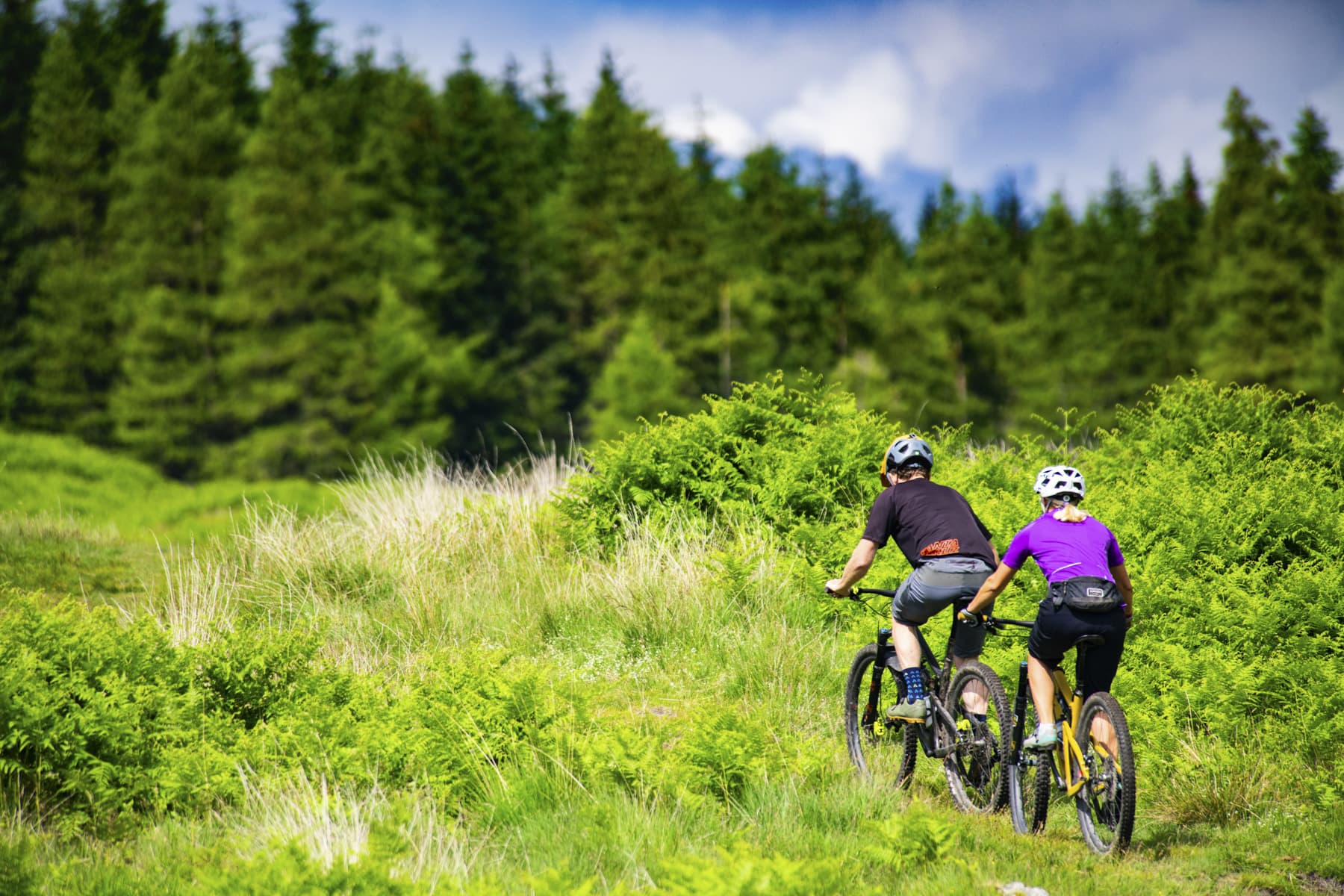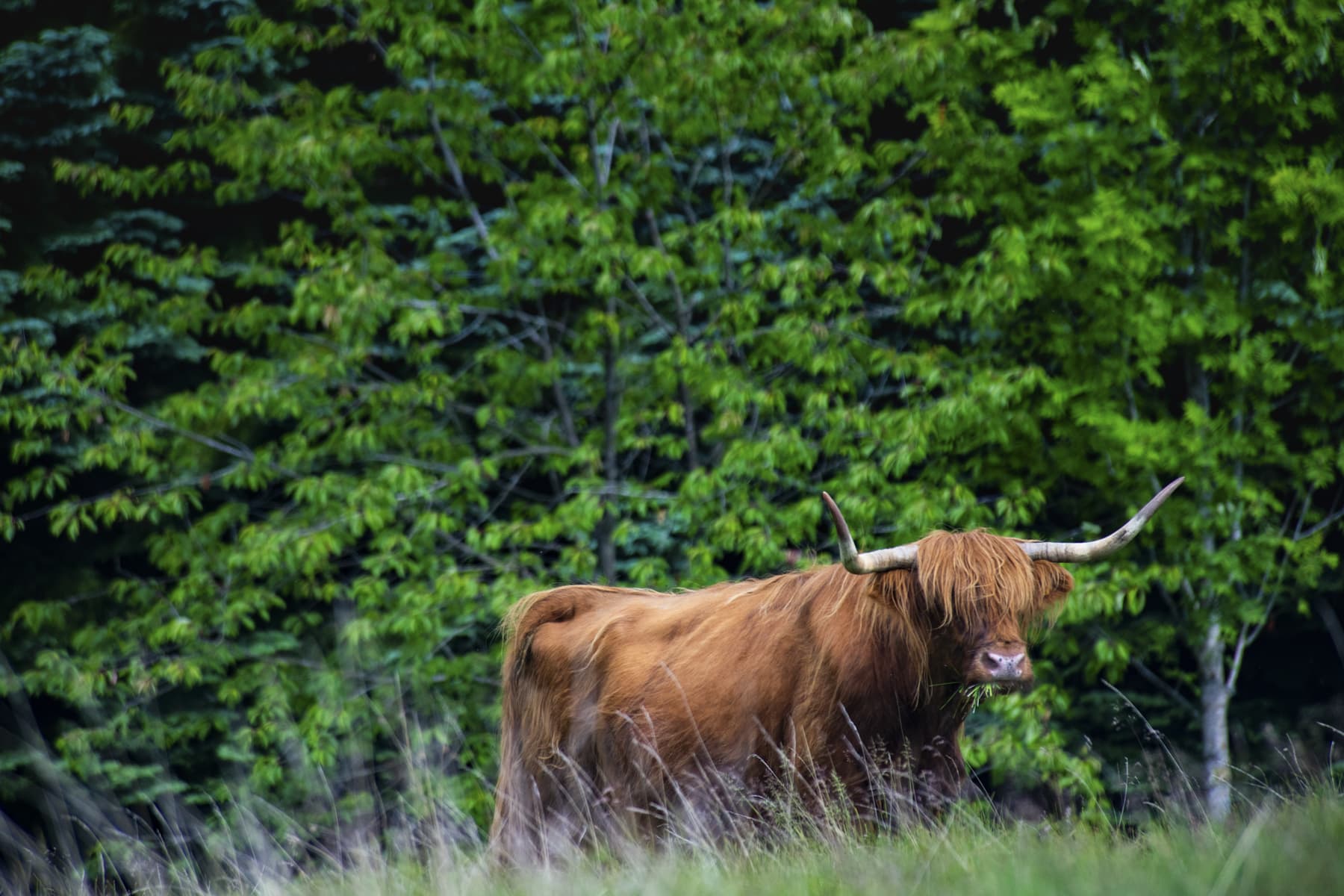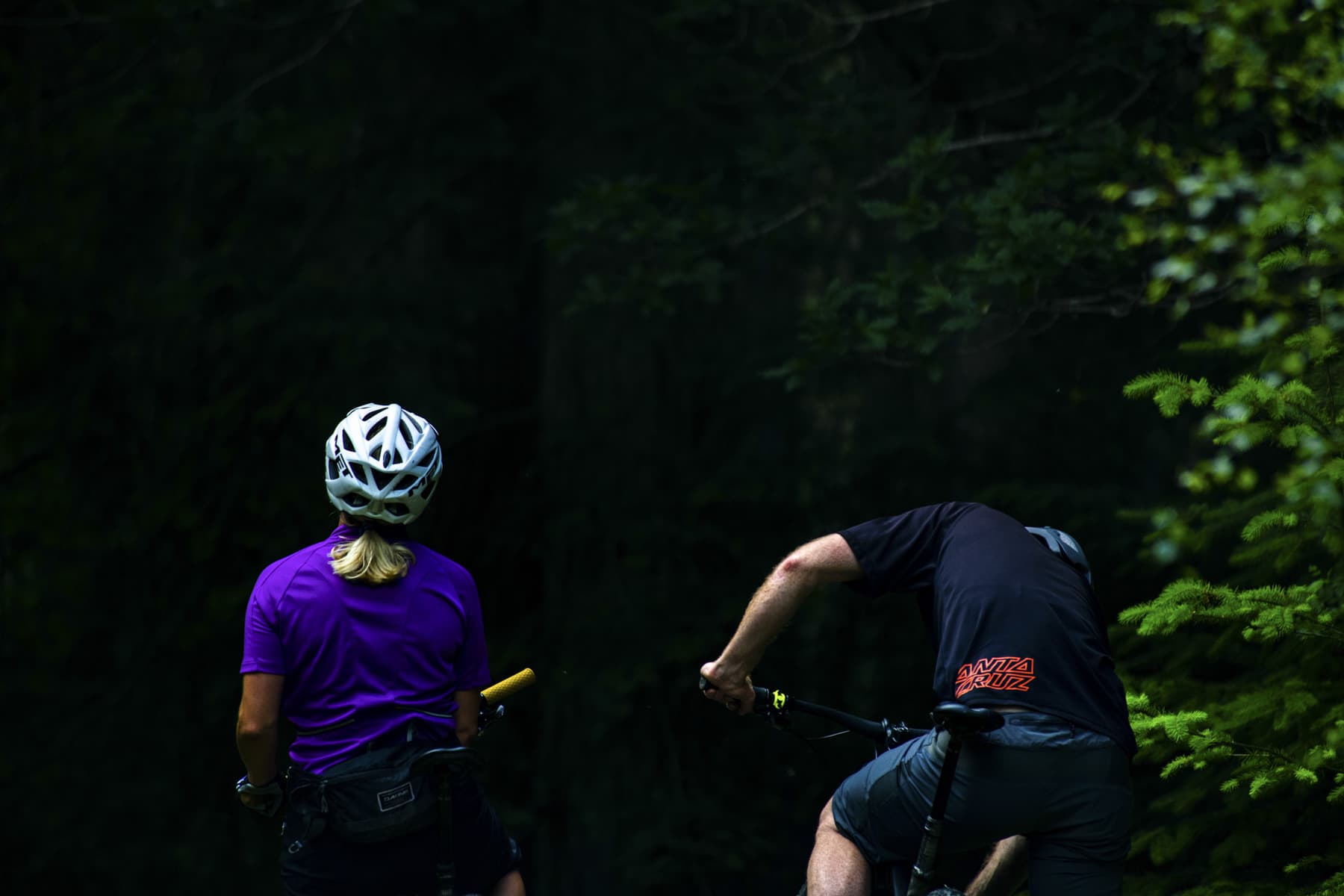Pete Scullion takes us on a tour of the endless, accessible fire roads and exciting singletrack on the very edge of the Scottish mountains.

Words & Photography Pete Scullion
The Trossachs… A sleepy corner of Scotland where the wide open spaces of the lowlands meet the first ripples of the Highlands made famous by Sir Walter Scott and William Wordsworth following their writings on one of the area’s most famous men, Rob Roy. Their work drew in Victorian visitors on a train line long since closed. Nowadays visitors come from Glasgow and Stirling, much the same as they did a century and a half ago, to wander about the woods before eating ice cream on the main street.
Recently, thanks to some industrious locals, the riding scene has exploded, and way more than just in the microcosm of fat tyres. The omnipresent road fraternity who come to cycle the flats of the Forth Valley before taking on the Duke of Montrose’s legacy, the Duke’s Pass, have been augmented by an ever-growing gang of gravel enthusiasts, while the mountain bikers choose to either hammer out the miles, or opt for a ‘winch and plummet’ on the hand-cut delights in the plantation forests that overlook the village of Aberfoyle.

You’ll have a real quandary when trying to decide a route between a group of riders, such is the plethora of options to add distance, altitude, bolt on or even remove certain types of riding. Whatever you end up riding, there’s no public transport to get you here – but that is part of the magic. Stray away from the village and you’ll soon find yourself in splendid isolation; just make sure you come prepared. Climbs are long, it will rain, you’ll get chewed by midges in the summer and it will be humid. That said, if you come with enough waterproofs, year-round riding isn’t inaccessible here either. You might just want to stick to slithering about the woods in the winter.
Not all that long ago, Aberfoyle wasn’t doing as well as it is now. Boarded-up shopfronts are now alive with a resurgence of tourist traffic, many with bikes, again, thanks to industrious locals. My two companions today, Rob Friel and Amber Thomson, make up half of the small team that forms the nucleus of the Dukes Weekender gravel event; a weekend that saw many local businesses recording their busiest days in years. Whether you drop into the Forth Inn or the Faerie Tree, Maggie’s Aberfoyle Kitchen or the Aberfoyle Deli for food, you’ll be getting the best of what the local area has to offer from someone who has become a cornerstone of how the village operates. That barely scratches the surface, and only on food – beyond the main street there are plenty more hidden gems to be found.
Once you’re fuelled up, almost all the routes involving a serious turn of wider tyres on dirt will send you north between the hills of Craigmore and Limecraig, both of which show the scars of the mining industry that used to dominate the landscape, on a long, steady climb that steepens cruelly, but gains height fast and offers views. On this day though, we’d opted to climb this hill from the north and skirt it to tackle the infamous Menteith Hills.
The opening portion of this route takes in part of one of Scotland’s least appreciated long-distance paths, named after the infamous Rob Roy MacGregor, born on the shores of Loch Katrine and immortalised by Scott and Wordsworth. While it lacks the nearby West Highland Way’s infrastructure and the traffic that brings, there is a real charm in heading into the hills knowing that the few people you do meet will be there for very much the same reason as you. Taking on a much wilder feel once you’re beyond the Aberfoyle golf course and beyond Braeval, this is just the start of showing just how diverse the terrain and forests can be in this part of the world.
Owing to the proliferation of felling in these parts, both ongoing and complete, you’ll mostly find the fire roads here well-hammered and fast, meaning you’ll find your way along the tamer sections quickly before being spat back into every kind of singletrack you could think to ride. That is the real beauty of heading to the Menteiths before swinging north and west, then south again to complete the loop. While you’re on the Rob Roy Way, route markers make this portion of the ride fast and easy.
Once at the end of the fire road above Braeval, you’ll need to re-engage your brain as the singletrack here is ever-changing with the weather and the bedrock slabs aren’t always as inviting as they might first appear. Thankfully, we’ve experienced unseasonably dry conditions of late, with only the odd bit of rain as the days became longer, in stark contrast to the month of rain we had in early 2020. Thankfully, therefore, it’s tall bracken, long tree limbs and flies that make this pedal slightly different.
Opening undulations sharpen the senses and by now, the humidity is starting to turn our faces rosy with beads of sweat. Amber claims: “This will probably be the slowest ride you’ve been on in ages,” to Rob, World Record holder on the track, and a constant threat on the Scottish road and cross-country scene, whose eyes haven’t stopped popping out of his head since he swung his leg over a borrowed Hightower. I am comprehensively having my legs ripped off; my eyebrows are wet from my leaking skin long before the others spin away from me into the cool darkness of the plantation. It’s here where the lack of attention the Rob Roy Way receives is normally visible – this section is usually a slick mess that never sees daylight as the water that pours off the hill above churns the mud into a quagmire. I honestly haven’t ever been through here quicker than I have today – there’s barely a mark of dirt on my tyres as we enter what is somewhat of a unique bit of trail for these parts.
Open up and say ‘Aaaah’
With a reassuring creak the metal gate marks the end of the plantation, which gives way to open grassy hillside, home to some Aberdeen Angus and English Shorthorn cows along with this year’s wee ones. It’s here the bracken begins to take over as the rock and undulations into small streams continue. Weave your way gently through the cattle and keep one eye on what’s in front as there are a few sections along this flowing ribbon of singletrack that need your full attention. In the winter this is made all the more difficult by the attentions of hooves combined with copious amounts of sky juice, but for now, we’re content to keep moving to keep the sweat and the flies at bay, while our heads just clear the top of the bracken.

Another groaning metal gate gives way to the recently resurfaced portion of the route where the feel changes yet again. Plantation is king again, but only on one side, and the damselflies [like a small dragonfly – Ed] and herons that frequent the lochan give you the first view of one of the many bodies of water on the route. With the Scout Path descent waiting to be reinstated once the logging wraps up on the north side of the hill, a short, sharp fire road blast brings us to the southern shore of Loch Venachar, and it’s almost as if we’ve ridden into a different country.
Across the loch, the first real indication of the Highlands beyond to the north of Aberfoyle are evident. Ben Ledi stands tall on the northern shore, with Ben Venue at its western end. These mountains rise abruptly out of the water, the former some eight hundred metres higher than the water’s edge in only twice the distance.
Ancient woods
We pick up the NCN 7 again after having left it behind when we made our way onto the Rob Roy Way, for a fast, sweeping blast along the lochside. Here, tall ancient trees of fir and oak form twisted shapes through the rhododendrons and the arrow-straight frontier species give the trail a much lighter feel than the plantation where the colour green is in full effect. We’re passed by countless cyclists on all manner of bikes, enjoying this gem of a trail.
As with anything around here, a stiff climb isn’t ever too far away and, in this case, the next is a real joy despite the complaining legs. With the high sun casting few shadows and making the forest bright green in every direction and the rain having consolidated the gravel beneath us, it has all the right ingredients for a good climb. We’re so busy enjoying the surroundings that we barely notice we’re at the head of Loch Drunkie – another one of the bodies of water in the Trossachs that was raised to provide water for Glasgow’s ever-expanding 19th century population.
As if synchronised, Rob and Amber take a cursory glance at their watches, the time set by family commitments adds an urgency to proceedings that is taking its toll on my pace. With these two setting the timetable, it’s unlikely we’d be getting a real snack stop. “It’s only 13 miles anyway…” Trail mix is inhaled whenever we stop to regroup, and from Drunkie, it’s a long, steady pedal from the lochside to the highest point on the ride. The Aberfoyle slate quarry can be seen across the Duke’s Pass, a quarry that brought in Welsh slate specialists many moons ago, the caverns of which are now home to countless bats.
From the high point here, the options for the final descent are limitless. Fire roads split off in every direction, leading to everything from the sublime to the ridiculous, official and unofficial, and easily lapped multiple times for anyone with the energy left at the ten-mile mark. With time pressing, we opt for the direct approach. A swift clatter down to the Allt a Mhangaim waterfall, which is worth a visit on its own, and onto one of the waymarked Forestry routes that offers a fast blast with a few surprises of rock and root to wake you up again before you’re spat out onto the main street once again.
Why bother?
Aberfoyle lies less than an hour north of Glasgow and west of Stirling, offering a real taste of rural Scotland without the massive drive into the Highlands proper. With almost everything clustered along a single main road, you don’t have to go far to find yourself on your own in some proper landscape, a landscape that can inspire poets and playwrights. Come back more than once and you’ll discover something new that you can’t find by just looking on a map or following a guidebook, and you’ll be confronted by postcard views with no evidence of mankind’s intervention other than the trail under your tyres.

Variety is the real key here. You can ride fire road for days if that’s what you want, or, assuming you’re following the rules of the Land Reform Act, finding a line on an old map and going to see if it’s still there is a mission often well worth undertaking. You may end up knee-deep in foul-smelling black gunk on four out of five occasions, but the fifth will be the solid gold that will keep you coming back.
You don’t have to go far to ride a big old mountain either. You can spend days slithering about the woods, or hammering singletrack across the hills, then hike-a-bike to a proper mountain summit and breathe in a panoramic view.
The seasons play a massive part in how this area feels. Spring sees everything come alive and with the amount of rain on offer, green is king. Snow can linger on the northern slopes of higher places into May on occasion. Deer, eagles, ospreys, and falcons aren’t uncommon and you’ll not go a ride without seeing a buzzard or ten. Summer brings the midgies and the bracken while autumn brings with it orange in abundance. You can hear stags bellowing out their challenges, the larch goes golden, as does the bracken, and you will never see a clear night sky like we have here.
The village has yet to see anything like the attentions of large business, with the Co-op and the MacDonald Hotel being the only mainstream outfits here, giving Aberfoyle a unique charm. Even the petrol station and shop is community-owned. Cash spent in Aberfoyle invariably stays put.
The Knowledge
- Distance: 21.7km
- Elevation: 549m
- Time: 2–4 hours
- Map: OS Landranger 57
- Aberfoyle has a few inns, B&Bs and hotels, plus myriad private options and Airbnbs. With Scotland’s Covid-19 rules differing to the rest of the UK, all services below may still be closed or operating at reduced capacity.
- The Forth Inn. Slap bang in the centre of the village. Six rooms and probably the best sit-down meal in the area.
- Rob Roy Hotel. Just outside the village at the A81/A821 roundabout, with 100 rooms of all shapes and sizes and a copious car park. Popular with bus tours, so book in advance.
- Craigmore Guest House. Ten rooms, just off the main street, off-street parking.
Park in the rather massive 300-space Riverside Car Park just south of the main street. FK8 3UQ
- Aberfoyle Bike Hire is the only bike shop in the village – it offers repairs and servicing, as well as essential supplies. The petrol station also stocks essential bike spares.
- Country Cycles in Killearn is the nearest specialist bike shop stocking Cube and Santa Cruz.
- You’re best bringing any spares specific to your bike.
- The Forth Inn. Everything on the menu is good. Service is excellent and the selection of adult beverages extensive. Live music and sport, traditional music nights… the works.
- The Faerie Tree. Pizza, burgers, steak and a kids’ cinema to keep the wee ones entertained.
- Chip shop. Recently reopened and offering excellent cook-to-order goodness.
This feature was produced with support from Komoot.
For more details of this route and others, head to singletrackworld.com/komoot to follow us.



















